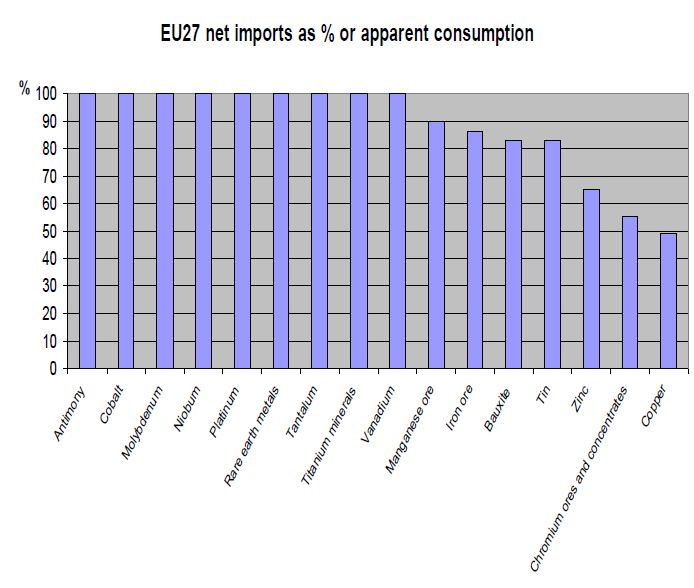Zero Waste to reduce EU dependency on materials
The clever thing about minimising waste and recycling stuff is that we recover the materials and we can use them again instead of having to import them from far at increasing prices.
The resources in the world are not only limited; they are also becoming more and more scarce and hence more difficult, polluting and expensive to extract. In absolute terms, Europe is using more and more resources. For example, resource use increased by 34 % between 2000 and 2007 in the EU-12. This continues to have considerable environmental and economic consequences. Of 8.2 billion tonnes of materials used in the E-27 in 2007, minerals and including metals accounted for more than half, and fossil fuels and biomass for about a quarter each.
In the following graph we can see how heavily dependent is the EU from imports of metals (source EEA).
For the majority of metals the EU depends 100% on its imports. At the same time what we see is that in the EU 50% of the recyclable municipal waste is landfilled or incinerated and the exports –legal and ilegal- of metals and electronics to be recycled –mostly downcycled- have increased. From the strategic point of view –let alone environmental and economical considerations- this is nothing less than stupid.
The recycling sector in Europe has an estimated turnover of EUR 24 billion and employs about half a million persons. Thus, the EU has 50 % of the recycling industries in the world. Yet, the EU lets most of its electronic waste to be shipped abroad for low quality recycling when nobody in the earth needs more the resources than the EU.
The EU has been producing legislation to try to shift this exodus of materials into european recycling plants. So far the directive on waste from electric and electronic equipment has required that every member state collects 4kg per capita per year but right now there are countries like Belgium or Germany that are well above this target whilst others are far below. The revision of the WEEE aims to collect 65% of generated WEEE by 2016 which is a very necessary improvement to create jobs and a solid recycling industry in Europe that reduces necessity to extract, process, and transport the materials that we need.
Some companies are proving that, if they are given the chance, they can recover most of the materials and generate jobs and economic activity whilst avoiding the extra emissions of exporting waste for disposal and having to extract and manufacture new materials. Umicore, for instance, is one of the leading companies in Europe in recycling of WEEE and shows the changing trends; from being a belgian mining company with poor environmental record they understood that the future was to focus not on extracting materials from the earth but rather to extract them from the already produced equipments that had become waste. Thanks to this Umicore has not only managed to be a world leading recycler but it has also managed to pay its environmental liabilities.
Umicore treats 300.000 tones of electric and electronic waste from which only 15.000 tones become waste; that is 95% of the waste is recycled. Whilst there are some rare earths present in small devices such as mobile phones and which so far can’t be recovered the truth is that most metals are recovered at a higher rate than what can be achieved in backyard recycling –what would happen if exported outside Europe-. For instance, in Umicore 95 to 99% of gold is recovered whilst in backyard recycling only 20 to 25% can be recovered –with a lot higher enviornmental and health impact-.
It is therefore possible to close the loop in some sectors of our economy but in order to do so it is necessary that the authorities collaborate with the right legislation and market drivers. Highly efficient recycling systems keep jobs in Europe, reduce dependency from imports, lower emissions, reduce environmental impact in third countries and help move in the direction of sustainability if they are combined with the right prevention tools.
Zero Waste is about reducing the use of materials, reusing them as much as possible and recycling them as last option. Europe can’t afford to continue trashing resources; eliminating waste with incineration and landfills don’t make sense, but this is even more true in the case of electric and electronic waste.
The resources in the world are not only limited; they are also becoming more and more scarce and hence more difficult, polluting and expensive to extract. In absolute terms, Europe is using more and more resources. For example, resource use increased by 34 % between 2000 and 2007 in the EU-12. This continues to have considerable environmental and economic consequences. Of 8.2 billion tonnes of materials used in the E-27 in 2007, minerals and including metals accounted for more than half, and fossil fuels and biomass for about a quarter each.
In the following graph we can see how heavily dependent is the EU from imports of metals (source EEA).
It is possible to close the loop in some sectors of our economy, but in order to do so it is necessary that the authorities collaborate with the right legislation and market drivers.
